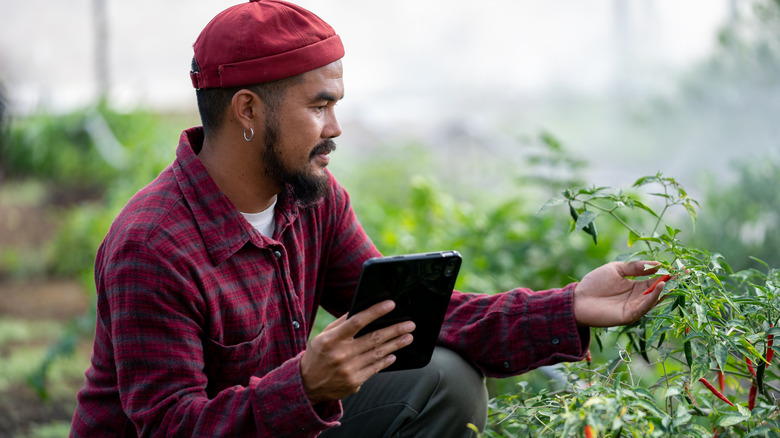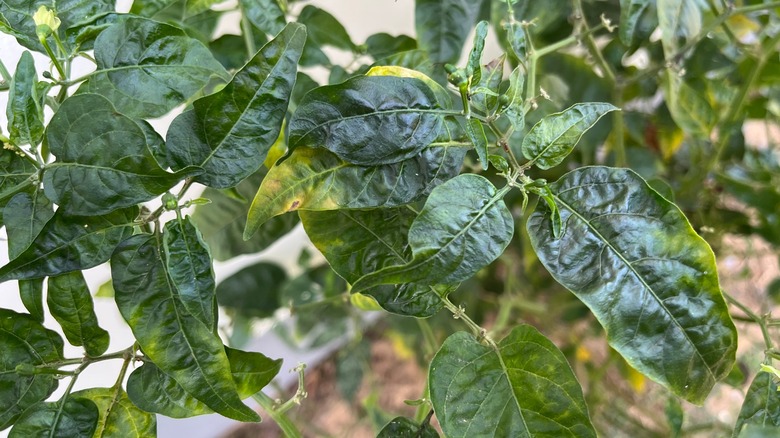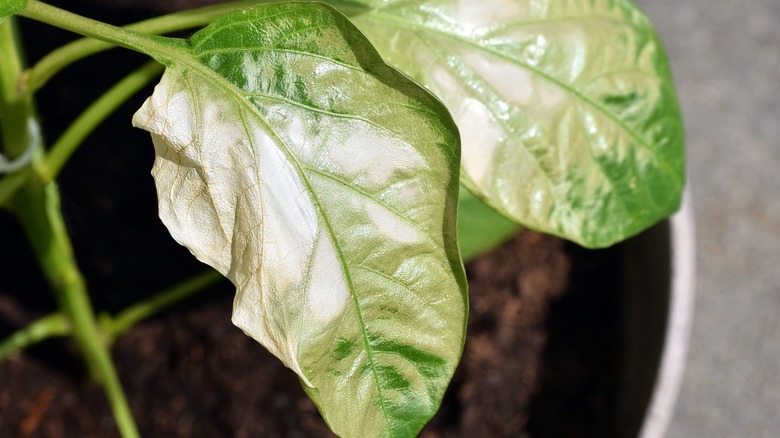Are Your Dying Peppers Suffering From Overwatering Or Sunscald? Here's How To Tell
After all the love and attention you've lavished on your vegetable garden, it can be devastating to watch your plants suffer and fail to thrive. This is especially disheartening with peppers as they tend to be slow growing, meaning that if you lose your plants midseason, it may be too late to try again. Your first impulse when seeing your pepper plants on the verge of death may be to immediately do something — anything — to try to help them. While understandable, depending on what is going on with your peppers this could actually make the situation worse. Instead it's best to first examine the plants carefully and diagnose what is wrong with them, as many problems, including sunscalding and overwatering, can look extremely similar at first glance.
Because peppers hail from Central and South America and generally enjoy full sun and warm temperatures, it can be easy to assume they can handle even the warmest temperatures and most intense sun. This isn't necessarily the case though, and young leaves and developing fruit can be quite vulnerable to sun damage. This sun damage usually appears as white blistered spots on the leaves and fruits. On the other hand, if your peppers leaves are instead yellow and your fruits are developing soft black spots near the bottom, then watering problems and the nutritional deficiencies that often accompany inconsistent watering are the more likely culprits.
Diagnosing and treating overwatering in peppers
Peppers require consistent hydration to grow well, and they generally need about 1 to 2 inches of water per week, though peppers grown in containers may need more. It is possible to have too much of a good thing though, and overwatering your peppers can be just as damaging as underwatering. Overwatered peppers often struggle with calcium deficiencies, as improper or inconsistent irrigation can make it difficult for them to uptake minerals correctly. It may be difficult to definitively diagnose this problem based only on the leaves, but if your fruits are also suffering from blossom end rot, then you should take a good look at your watering strategies. While it is possible that your rotting peppers are caused by a true lack of calcium in the soil, it' more likely that inconsistent watering that alternates between over- and underwatering is the primary issue.
If your pepper is only suffering from mild symptoms like slightly yellow leaves, then simply watering deeply, but less often, may be enough to solve the problem. Mulch is also an invaluable ally, as it helps keep water levels in the soil more consistent. If you suspect your pepper's roots are extremely damaged or you've realized you planted your pepper in soil that is far too heavy and moisture-retentive, then it may be worth digging the plant up and transplanting it to attempt to save the plant and deal with the root rot.
Diagnosing and treating sunscald
While peppers whose sunscalded spots have been infected by disease may look a bit like peppers suffering from overwatering, sunscald generally starts out as white spots. Sun damage tends to make leaves have pale and crispy areas, and it's especially common if you don't harden off your plants. But it can still be a problem for the fruits later in the season, especially if they aren't shaded by the plant's leaves. Younger peppers that are still green are especially vulnerable.
While mild sunburn on a leaf or two following transplanting isn't necessarily a major concern —most plants recover well from minor sun damage — serious damage to fruits and foliage are signs your plants need more protection. To protect your peppers from sunscald, make sure you keep insects away from your pepper leaves, as healthy leaves are essential for protecting developing fruit from sun damage. You may also need to create some shade to protect your pepper plant. This can be as simple as moving container plants to a more protected spot in your garden, but you may need to get creative for shading peppers grown in ground. Another way to protect your developing fruits is by coating them in kaolin clay. In addition to protecting your plants from sunscald, this clay can also protect against some insect damage, making your plants healthier and more resilient.


